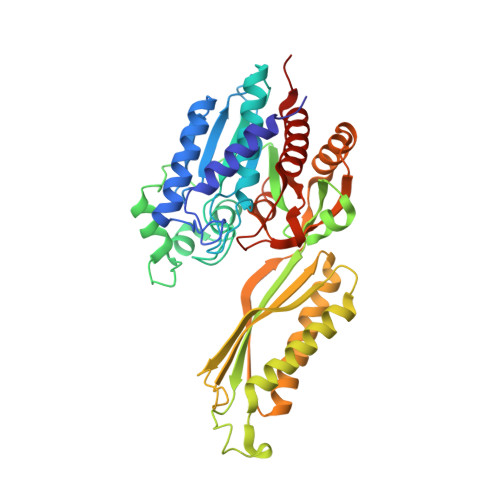Structural and biochemical characterisation of the N-carbamoyl-beta-alanine amidohydrolase from Rhizobium radiobacter MDC 8606.
Paloyan, A., Sargsyan, A., Karapetyan, M.D., Hambardzumyan, A., Kocharov, S., Panosyan, H., Dyukova, K., Kinosyan, M., Krueger, A., Piergentili, C., Stanley, W.A., Djoko, K.Y., Basle, A., Marles-Wright, J., Antranikian, G.(2023) FEBS J 290: 5566-5580
- PubMed: 37634202
- DOI: https://doi.org/10.1111/febs.16943
- Primary Citation of Related Structures:
8C46 - PubMed Abstract:
N-carbamoyl-β-alanine amidohydrolase (CβAA) constitutes one of the most important groups of industrially relevant enzymes used in the production of optically pure amino acids and derivatives. In this study, a CβAA-encoding gene from Rhizobium radiobacter strain MDC 8606 was cloned and overexpressed in Escherichia coli. The purified recombinant enzyme (RrCβAA) showed a specific activity of 14 U·mg -1 using N-carbamoyl-β-alanine as a substrate with an optimum activity at 55 °C and pH 8.0. In this work, we report also the first prokaryotic CβAA structure at a resolution of 2.0 Å. A discontinuous catalytic domain and a dimerisation domain attached through a flexible hinge region at the domain interface have been revealed. We identify key ligand binding residues, including a conserved glutamic acid (Glu131), histidine (H385) and arginine (Arg291). Our results allowed us to explain the preference of the enzyme for linear carbamoyl substrates, as large and branched carbamoyl substrates cannot fit in the active site of the enzyme. This work envisages the use of RrCβAA from R. radiobacter MDC 8606 for the industrial production of L-α-, L-β- and L-γ-amino acids. The structural analysis provides new insights on enzyme-substrate interaction, which shed light on engineering of CβAAs for high catalytic activity and broad substrate specificity.
- Scientific and Production Center "Armbiotechnology" of NAS RA, Yerevan, Armenia.
Organizational Affiliation:


















